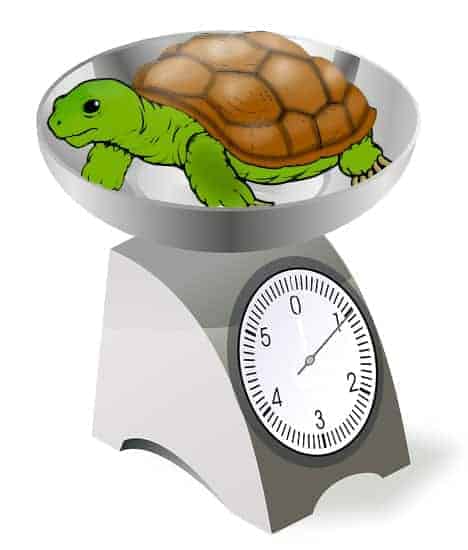
Ensuring your tortoise is a healthy weight is important, particularly during the early years of life when they are still growing.
Once a tortoise reaches maturity weight monitoring is less critical, but it is nonetheless still important to keep a casual eye on it to ensure the tortoise is eating properly and not suffering from any other health conditions. Unexplained weight loss can be a sign of underlying health issues that may warrant veterinary attention.

What constitutes a ‘healthy’ weight for a tortoise of a given age will depend on the species. For some species, particularly of mediterranean heritage, the job of determining healthy weight is much easier because there are some standard methods of measuring and determining whether a tortoise’s weight is healthy.
Jackson Ratio
For mediterranean tortoises, or more specifically Hermanns tortoises and Greek Spur Thigh tortoises, a measurement known as the ‘Jackson Ratio’ is commonly used to determine whether or not such a tortoise is of a healthy weight relative to their size. This is particularly critical when it comes to hibernation, as a certain amount of body fat is required to sustain a tortoise whilst they ‘sleep’ for several weeks or months on end.
The basic premise of the Jackson Ratio is to calculate the relationship between the tortoise’s weight and body length, effectively determining the ‘density’ of the tortoise. The resulting figure will typically range from between 0.16 and 0.23, with anything below 0.19 being considered too light to hibernate. In which case will mean the tortoise cannot be hibernated and must be ‘overwintered’ instead.
Check out this handy Jackson Ratio calculator to see how your tortoise fares.
Donoghue Ratio
More generic than the Jackson Ratio, the Donoghue Ratio can be applied to more species than the Jackson Ratio, so is considered a good rule of thumb the basic formula is as follows:
Carapace length in centimeters cubed, multiplied by 0.191 (SCLcm³ x 0.191)
This will give the ideal weight for the tortoise based on its size, which you can then compare to your own tortoise..
Note that carapace length refers to the end to end length of the shell (see below). This can be tricky to measure, but the simplest way is to place the tortoise right up against a wall such that their head retracts (don’t worry this won’t hurt as long as you’re careful and isn’t cruel so long as you only do it on occasion).
By then placing a piece of paper under the tortoise and right up against the wall as well you can then mark a line in line with the back of the carapace giving you a pretty accurate marking that you can then measure with a ruler.
The same method of measuring length applies when measuring to calculate the jackson ratio.
How Important is Weight Monitoring?
There are many in the tortoise keeping world who don’t subscribe to the idea of closely monitoring the weight of their pet tortoises, with the obvious exception of checking hibernating species prior to putting them to sleep for the winter.
Instead the thought is that simply maintaining a healthy diet and paying attention to other visual indicators of good or poor health is more useful than obsessing over the odd gram here and there.
The best policy is simply to be sensible about it. Knowing the weight of your tortoise can be a powerful indicator of their health, particularly when there are no other obvious signs of trouble. So as a tool to be used alongside other knowledge and practices, it certainly doesn’t hurt to dig out the scales every few months.
What Causes Weight Loss?
Dehydration
Like all living creatures, water constitutes a large chunk of the body weight of a tortoise, such that dehydration is a major cause of weight loss.
To prevent dehydration it’s important to encourage your tortoise to take on water regularly, particularly in the case of juveniles who are growing and may also need to be ‘taught’ to hydrate. There are a number of ways to do this, but actively placing your tortoise in a shallow water tray to ‘soak’ for several minutes is the surest method.
Ensure the water is lukewarm as cold water will likely cause the tortoise to exit the tray as soon as you place them in it. If they’re content bening soaked however then they should begin to drink through their mouths, and also take on water through the other end as well. Honestly! This is why soaking is so effective.
Besides soaking I like to spray my tortoise’s food with water, which is a very effective way of providing hydration, particularly if they like to eat more than they do drink. A similar result can be achieved by providing foods rich in water such as prickly pear or cucumber. Just be sure to provide other nutritious foods in addition to overtly watery foods as there is the risk of developing vitamin deficiency otherwise.
Poor Diet
Just as a lack of hydration can cause weight loss, so too can a poor diet. As an example many people erroneously choose to feed their tortoise iceberg lettuce. This contains very little nutritional value besides water, and none of the proteins, fats and other nutrients necessary for healthy growth and weight gain.
So whilst hydration is clearly important, it isn’t the complete picture, and the danger is that your tortoise may become ‘addicted’ to lettuce and take no interest in other foods, inadvertently starving themselves of adequate nutrition.
Parasites
Gastro intestinal parasites can be a real problem for tortoises both in the wild and in captivity. Unsanitary conditions can soon lead a tortoise ingesting the eggs of various worms, which can cause all manner of problems, from diarrhea, vomiting or a loss of appetite.
Check out this article for further information on worm infections in tortoises



